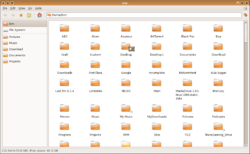File manager
A file manager is a computer program that provides a user interface for managing files and directories. The most common operations performed on files or groups of files include creating, opening (for example: view, play, edit, or print), rename, copy, move, delete, and find files; as well as modify its attributes, properties and access permissions. Folders and files can be viewed in a hierarchical tree based on their directory structure. Some file managers contain features inspired by web browsers, such as forward and back navigation buttons.
History
The first file managers were created for operating systems with symbol (non-graphical) user interfaces. These file managers generally represented drives, partitions, and directories in their actual physical layout and allowed a limited number of operations on these resources. The first visual file manager to be developed (although still in text mode) was Dired, which laid the foundation for the file managers that followed. With the advent of graphical interfaces, file managers acquired different functionalities, such as the ability to associate file types to programs, and they facilitated the understanding of concepts through the graphical representation of each resource, identified with an icon.
Nevertheless, there is still active development of various file managers under text interfaces, given their convenient portability and ease of use when administering Unix family systems.
Orthodox File Manager
An Orthodox file manager or OFM for its acronym in English (Orthodox file managers) or "commanders" is a type of file managers based on commands that commonly have three work areas composed of two symmetrical panels each with information from a directory and a command area. These types of managers were very common because they avoided using console commands directly to manage files and directories, which offered a lot of flexibility before the appearance of managers with graphical interfaces. Among the most famous was Norton Commander developed in 1986 that ran on DOS and that inspired other managers such as Midnight Commander and Total Commander that are still used in operating systems such as Windows and Linux as a substitute for the file managers that these systems have for default by adding certain features that facilitate file management using only the keyboard or with minimal use of the mouse.
List
For GNU/Linux
- Krusader, very powerful, high integration with KDE.
- emelFM2, based on GTK+2.
- Thunar, file manager of the XFCE project.
- PCManFM, written in GTK.
- Dolphin, file manager of the KDE project.
- Konqueror, web browser and file manager of the KDE project.
- Nautilus, file manager of the GNOME project.
- Nemo un fork de Nautilus.
- 4Pane, very complete and configurable, based on GTK. Website.
- Xfe, by "X File Explorer", of light type.
- BSCommander or Beesoft commander. Website. Latest development: September 2008.
- Rodent, graphical terminal (graphic shell) that depends on the GTK libraries. Website
- ROX-Filer
- GNOME Commander, supports Samba/FTP connections.
- Tuxcommander, it depends on the GTK libraries. Website
- Double Commander, MC graphical replacement. Website
- Gentoo (administrator), based on GTK+2. Website. Latest development: October 2011.
- filerunner, a very minimalist file manager. Use wish/tcl/tk.
- worker. Website
- MuCommander Website
For MS Windows
- Windows Explorer, default file manager for Windows 95 onwards.
- STDU Explorer File Manager for Windows.
- xplorer2, for many considered the best file manager. It has a "lite" version that is freeware.
- Total Commander very powerful file manager.
- Double Commander, written in Free Pascal/Lazarus.
- SE-Explorer, very simple interface.
- XYplorer
- ZTreeWin
- Konvertor FM
With text-based interface
Some file managers with text interface are:
For GNU/Linux
- Dired, configurable and very extensive reimplementation under Emacs (both text and graphic mode) cross-platform.
- Midnight Commander, Norton Commander clone for Unix.
- Vifm, ncurs-based interface, uses Vim-type keyboard shortcuts, here
For MS-DOS
- Norton Commander, powerful file manager for DOS.
- Two Navigator, another file manager for DOS.
- Volkov Commander
- XTree
- PathMinder
- FAR Manager, by "File and ARchive Manager", also means "far off" in English.
Contenido relacionado
Gran Via station
Addendum: Email clients
TeX

